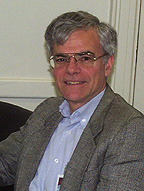
| T H E N I H C A T A L Y S T | J U L Y – A U G U S T 2001 |
|
|
|
| F R O M | T H E | D E P U T Y | D I R E C T O R | F O R | I N T R A M U R A L | R E S E A R C H |
BUILDING INFRASTRUCTURE FOR SCIENCE AT NIH:
THE THREE SIDES TO OUR STORIES
 |
| Michael Gottesman |
|
WITH
THE LOOMING SUPERSTRUCTURE OF THE CLINICAL
RESEARCH CENTER ON THE SKYLINE,
OUR HAT TRICK WILL BE COMPLETE: A BASIC SCIENCE BUILDING, AN APPLIED SCIENCE
BUILDING, AND A CLINICAL RESEARCH BUILDING
|
On June 14, NIH dedicated the Louis Stokes Laboratories (also known as Building 50)—the second new building to be opened on the NIH campus in the past year. The first was the the Vaccine Research Center, where intramural scientists started setting up shop late last summer. With the looming superstructure of the Clinical Research Center on the skyline, our hat trick will be complete: a basic science building, an applied science building, and a clinical research building.
http://www.nih.gov/catalyst/2001/01.07.01/page1.htmlThese structures manifest the three legs of the NIH research effort, which begins with advanced technologies and new approaches to integrative biology, involves the application of these approaches to public health problems (such as the development of vaccines against HIV and other diseases), and reaches its destination in the innovative clinical research with human participants (patients and healthy volunteers) carried out in the Clinical Center.
I hope you will all get a chance to visit the new Louis Stokes building. It is an attractive structure with a spacious plaza that beckons to visitors and employees coming onto campus from the Metro stop. And its beauty is well beyond façade-deep. The edifice has won several awards for unique designs that conserve energy.
The labs are open and sunlit, with ample space for storage and equipment. They are arranged in neighborhoods to encourage interaction among scientists, both horizontally (same floor) and vertically (adjacent floors). Use of interstitial space between the floors for utilities means that as science changes, new requirements can easily be met without disrupting the labs below and above. This will extend the usable lifetime of the building by many years.
The basement of the building houses a state-of-the-art vivarium and two unique spaces: a large chamber for big magnets used in NMR structural studies and a vibration-free slab with high-end electron microscopes for use in cryomicroscopy and electron crystallography.
This building replaces buildings 2, 3, and 7—and none too soon!
The Vaccine Research Center has been open for business since last fall (see The NIH Catalyst, September–October 2000, "VRC Takes Its Place in Campus Skyline").
It has an inviting atrium and two-story cyber cafe, as well as an electronically enabled conference center and terraces on the second floor. The labs are open with large windows. The many break areas encourage scientific interactions. The top floor has facilities to produce small amounts of material for early-phase vaccine tests, and there’s a small rodent vivarium below ground.
Recruitment to the VRC is well under way, and it should be fully staffed within the next few months. Staffing will emphasize the paradigm that drove the formation of the center: the resynthesis of immunology, virology, and vaccinology into a modern science that allows creation of effective vaccines against diseases that have proven resistant to traditional approaches. According to Gary Nabel, VRC director, the very first HIV vaccine trial based on a construct made in the VRC will soon start in the Clinical Center.
Work continues on the Clinical Research Center, which is scheduled to open in the late summer or fall of 2003. These new facilities will provide research beds and support for a modern clinical research facility and lab support for the clinical researchers who work there. Once the new CRC has opened, the original Building 10 will be renovated in phases, beginning with the central core of the building, to provide modern laboratory spaces for our scientists. We anticipate this process will begin in 2004.
Kudos to all of the people who have contributed to the concept, design, and construction of these magnificent new buildings, and to the scientists who will convert this infrastructure into biomedical progress.
—Michael Gottesman
Deputy Director for Intramural Research